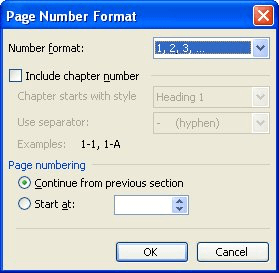Please Note: This article is written for users of the following Microsoft Word versions: 97, 2000, 2002, and 2003. If you are using a later version (Word 2007 or later), this tip may not work for you. For a version of this tip written specifically for later versions of Word, click here: Using Chapter Numbers with Page Numbers.
Written by Allen Wyatt (last updated November 30, 2024)
This tip applies to Word 97, 2000, 2002, and 2003
Word provides many different ways you can set up and use page numbers in your documents. Typically, page numbers are placed in either your headers or footers so that they appear on each page of the document. In other WordTips issues you learn how to specify the starting page number to be used within a document. Word also allows you to automatically include a "chapter number" as part of your page numbers.
Before you instruct Word to automatically include chapter numbers with page numbers, you need to make sure that you are using a named style for your chapter headings. For instance, you might specify the Heading 1 style to be used for chapters. Thus, anytime a Heading 1 style is used in your document, it signifies the start of a new chapter.
In addition, the style must be set up to use outline numbering. This type of numbering (also covered in other issues of WordTips) numbers the headings in your document. Thus, if you are using outline numbering, all of your Heading 1 paragraphs may begin with a number or letter, such as 1 or C.
With these two elements in place, you are ready to add chapter numbers to your page numbers. Follow these steps:

Figure 1. The Page Number Format dialog box.
WordTips is your source for cost-effective Microsoft Word training. (Microsoft Word is the most popular word processing software in the world.) This tip (1422) applies to Microsoft Word 97, 2000, 2002, and 2003. You can find a version of this tip for the ribbon interface of Word (Word 2007 and later) here: Using Chapter Numbers with Page Numbers.

Discover the Power of Microsoft Office This beginner-friendly guide reveals the expert tips and strategies you need to skyrocket your productivity and use Office 365 like a pro. Mastering software like Word, Excel, and PowerPoint is essential to be more efficient and advance your career. Simple lessons guide you through every step, providing the knowledge you need to get started. Check out Microsoft Office 365 For Beginners today!
Some people use quote marks around text to make it stand out. At some point you may want to treat the quoted text ...
Discover MoreWant to have objects such as text boxes and shapes always appear using some formatting you like? Here are some ideas on ...
Discover MoreWhen settling on an overall design for your document, you need to decide how you want your headings to appear. If you ...
Discover MoreFREE SERVICE: Get tips like this every week in WordTips, a free productivity newsletter. Enter your address and click "Subscribe."
There are currently no comments for this tip. (Be the first to leave your comment—just use the simple form above!)
Got a version of Word that uses the menu interface (Word 97, Word 2000, Word 2002, or Word 2003)? This site is for you! If you use a later version of Word, visit our WordTips site focusing on the ribbon interface.
Visit the WordTips channel on YouTube
FREE SERVICE: Get tips like this every week in WordTips, a free productivity newsletter. Enter your address and click "Subscribe."
Copyright © 2026 Sharon Parq Associates, Inc.
Comments